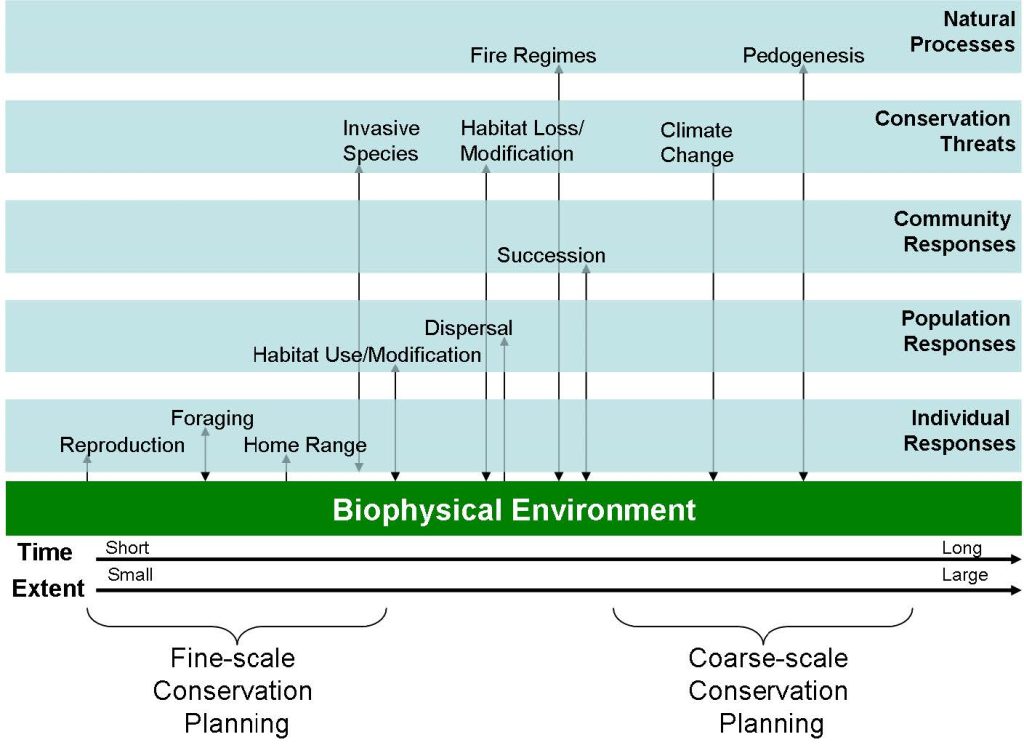In the context of conservation planning, scale has important implications that relate to:
- selecting processes, targets, and threats for consideration;
- the relationships between targets, their key attributes (Parrish et al. 2003), and processes or threats; and
- the kinds of data used and the applicability of planning results.
The first reason scale is important to conservation planning is that effects of natural and human-caused processes and events can only be observed or measured across specific scale ranges. Populations and distributions of conservation targets are not fixed in space and time but vary in response to natural and human-caused processes and events (Figure 2.2). In one sense, species distribution is a response variable dependent upon habitat covariates such as vegetation type, elevation, etc., which, in turn, are determined by underlying physical and biotic processes.

Figure 2.2. Biological, management, and biophysical process over spatial and temporal scales. Processes at finer scales are constrained by those operating at longer or larger scales. Thus, conservation planning at fine scales must take these constraints into consideration. Successful conservation planning starts with knowing what processes are significant to the persistence of a conservation target, both those that benefit it and those that threaten it (Parrish et al., 2003). Hence, the processes relevant to a conservation target will help determine the scales at which conservation planning should take place.
A second reason scale is important to conservation planning is that a species’ associations with its environment can appear different when observed at different scales. Consider the association between sage grouse (Centrocercus urophasianus) and agriculture at three different scales. Historically, sage grouse were found in sagebrush habitats across much of the western United States. The loss of sagebrush habitat to agricultural development is one contributor to their widespread decline across their range. So, at a range-wide scale, sage grouse are negatively associated with agriculture. However, sage grouse do use agricultural lands, because they are a rich source of the insects hens need for rearing their chicks. At an intermediate scale that encompasses multiple populations (e.g., the extent of one or several counties), good sage grouse habitat is considered to have a mix of high quality sagebrush habitat and agricultural fields (Schroeder et al. 1999). So, at this scale, sage grouse are positively associated with agricultural lands. Agricultural lands, though, do not provide important resources like cover, nesting habitat, or lekking areas that are important aspects of the sage grouse life cycle, and lack of these exposes sage grouse to increased risk of predation or disturbance. At the scale of an individual population, high quality sagebrush habitat is the essential, and often limiting factor to sustaining sage grouse populations in the face of agricultural encroachment. Thus, at the finest scales, sage grouse are again negatively associated with agricultural lands. In a hierarchy of conservation plans, agriculture can be treated as a component of habitat or a threat, depending upon the scale of analysis.
A third reason scale is important to conservation planning is that the synthesis of different data layers into an analysis scale produces an output that is specific to that scale. This means the results of a particular conservation plan cannot be scaled down, because data have been lost in aggregating to the analysis scale, and results cannot be predictably scaled up. When results from these models are downscaled to a scale of concern, such as 10-km grain, their accuracy is limited to that of the original projection. Ideally, the choice of an analysis scale for conservation planning would be the result of consideration of the scales relevant to the conservation targets. In practice, however, this is often not done. Analysis scales are selected arbitrarily or by convenience, leading to planning results that may not be applicable to the scales at which actions will be taken.
These issues are addressed in greater depth in Chapter 8.
Next Page: Sound science in conservation planning
Author
Bob Unnasch, Ph.D.
Sound Science LLC
Why scale is important to conservation planning
Why scale is important to conservation planning
